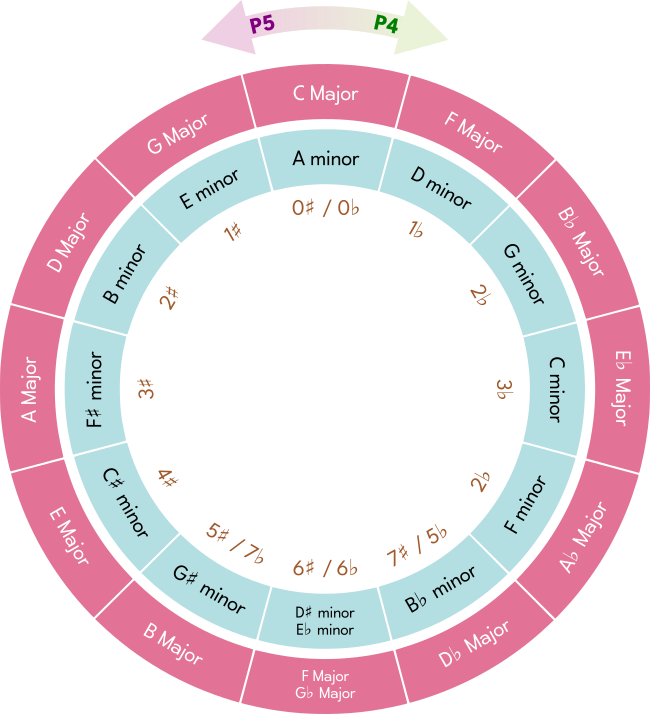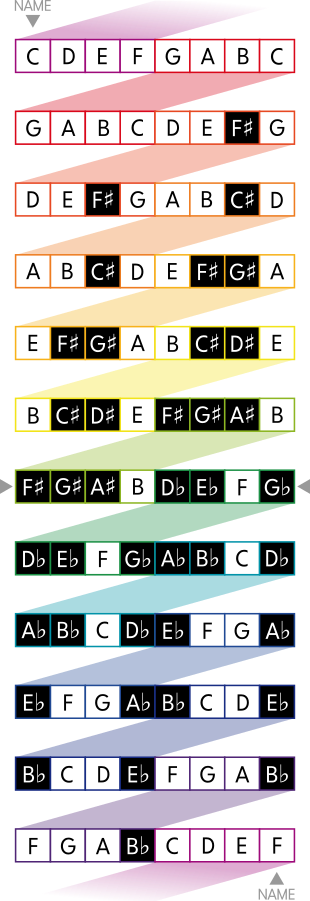Back • Return Home
The Tonal System
All Scales are written with seven letters (A through G), in order:
A-B-C-D-E-F-G
B-C-D-E-F-G-A
C-D-E-F-G-A-B
D-E-F-G-A-B-C
E-F-G-A-B-C-D
F-G-A-B-C-D-E
G-A-B-C-D-E-F
It is helpful to be able to recall this sequence of letters, forwards and backwards, starting from any letter.
There is a mirror pattern to which Notes are Flat or Sharp within each Key:
| 1 |
2 |
3 |
4 |
5 |
6 |
7 |
♭ / ♯ |
1 |
2 |
3 |
4 |
5 |
6 |
7 |
| A |
B |
C |
D |
E |
F |
G |
0 |
C |
D |
E |
F |
G |
A |
B |
| A♯ |
B♯ |
C♯ |
D♯ |
E♯ |
F♯ |
G♯ |
7 ♯'s |
C♯ |
D♯ |
E♯ |
F♯ |
G♯ |
A♯ |
B♯ |
| A♭ |
B♭ |
C♭ |
D♭ |
E♭ |
F♭ |
G♭ |
7 ♭'s |
C♭ |
D♭ |
E♭ |
F♭ |
G♭ |
A♭ |
B♭ |
| * |
* |
* |
* |
* |
* |
* |
* |
* |
* |
* |
* |
* |
* |
* |
| E |
F♯ |
G |
A |
B |
C |
D |
1 ♯ |
G |
A |
B |
C |
D |
E |
F♯ |
| E♭ |
F |
G♭ |
A♭ |
B♭ |
C♭ |
D♭ |
6 ♭'s |
G♭ |
A♭ |
B♭ |
C♭ |
D♭ |
E♭ |
F |
| * |
* |
* |
* |
* |
* |
* |
* |
* |
* |
* |
* |
* |
* |
* |
| B |
C♯ |
D |
E |
F♯ |
G |
A |
2 ♯'s |
D |
E |
F♯ |
G |
A |
B |
C♯ |
| B♭ |
C |
D♭ |
E♭ |
F |
G♭ |
A♭ |
5 ♭'s |
D♭ |
E♭ |
F |
G♭ |
A♭ |
B♭ |
C |
| * |
* |
* |
* |
* |
* |
* |
* |
* |
* |
* |
* |
* |
* |
* |
| F♯ |
G♯ |
A |
B |
C♯ |
D |
E |
3 ♯'s |
A |
B |
C♯ |
D |
E |
F♯ |
G♯ |
| F |
G |
A♭ |
B♭ |
C |
D♭ |
E♭ |
4 ♭'s |
A♭ |
B♭ |
C |
D♭ |
E♭ |
F |
G |
| * |
* |
* |
* |
* |
* |
* |
* |
* |
* |
* |
* |
* |
* |
* |
| C♯ |
D♯ |
E |
F♯ |
G♯ |
A |
B |
4 ♯'s |
E |
F♯ |
G♯ |
A |
B |
C♯ |
D♯ |
| C |
D |
E♭ |
F |
G |
A♭ |
B♭ |
3 ♭'s |
E♭ |
F |
G |
A♭ |
B♭ |
C |
D |
| * |
* |
* |
* |
* |
* |
* |
* |
* |
* |
* |
* |
* |
* |
* |
| G♯ |
A♯ |
B |
C♯ |
D♯ |
E |
F♯ |
5 ♯'s |
B |
C♯ |
D♯ |
E |
F♯ |
G♯ |
A♯ |
| G |
A |
B♭ |
C |
D |
E♭ |
F |
2 ♭'s |
B♭ |
C |
D |
E♭ |
F |
G |
A |
| * |
* |
* |
* |
* |
* |
* |
* |
* |
* |
* |
* |
* |
* |
* |
| D♯ |
E♯ |
F♯ |
G♯ |
A♯ |
B |
C♯ |
6 ♯'s |
F♯ |
G♯ |
A♯ |
B |
C♯ |
D♯ |
E♯ |
| D |
E |
F |
G |
A |
B♭ |
C |
1 ♭ |
F |
G |
A |
B♭ |
C |
D |
E |
The black and white squares represent the black and white keys on the piano. The middle column (in pink) shows how many Sharps and Flats each Scale has. To the right of this column are the Major Scales, and to the left are their Relative minors. Notice that the pattern of Sharps and Flats has a pattern. For example, the G Major Scale has one Sharp (F♯), while the G♭ Major Scale only has one Note that isn't Flat (F). They mirror one another! Also notice that we only use Sharps or Flats within a single Scale, never a combination of the two. If we know the seven letter sequence well, then these patterns can help us to remember which Notes are Sharp and Flat within each Scale, and be able to "spell" them out whenever necessary. This "spelling" is important.
[It is rare for piano music to have more than 5 Flats or more than 4 Sharps.]
Summary:
• 1 Key without Sharps or Flats
• 7 Keys with Sharps
• 7 Keys with Flats
• 15 Keys × 2 (for Major and minor) = 30 Keys Total
Enharmonic Keys:
C♭ and B
G♭ and F♯
D♭ and C♯
[Keys in bold are usually the more common spelling.]
There is also a pattern to how the Keys are related to one another and the Key Signatures that they have. It is called The Circle of Fifths because the Notes are an Interval of a "Fifth" away. In other words, they encompass five letters (e.g.: from A to E would be a "Fifth").
Going counter-clockwise is equivalent to going up a Fifth, and going clockwise is equivalent to going up a Fourth. Fourths and Fifths are Inversions. Therefore, this is also sometimes called The Circle of Fourths.
Order of Flats: B-E-A-D-G-C-F
Order of Sharps: F-C-G-D-A-E-B
The order of each is the reverse of the other.
This sequence is also worth committing to memory, both forwards and backwards. An easy way of doing this is through a silly mnemonic. While it is probably best to write your own mnemonic so that it will be personally meaningful to you, here is an example...
Order of Flats: "Before Eating A Doughnut, Get Coffee First."
Order of Sharps: "Forget Coffee, Grab Doughnuts And Eat Billions!"
The first four Notes of a Scale are called an "Upper Tetrachord", while the last four Notes of a Scale are called a "Lower Tetrachord". Notice how the Upper Tetrachord of one Scale relates to the Lower Tetrachord of the previous Scale on The Circle of Fifths. Here is a diagram which shows this pattern within the Major Scales:
This relationship is useful for practicing Scales in a way that builds upon itself and can be looped repeatedly. Start at the top of the diagram, play each Scale one after another in the order that they appear, and then go back to the top once you reach the end!


